Despite missing out on the 2018 World Cup, Wales will have fond memories of their previous Euros, in 2016, where they went as far as the semi-finals and proved to be the tournament’s surprise package. They looked all set to repeat their heroics this time around, having been put in a very underrated and open group alongside Italy, Turkey and Switzerland, but controversy off the pitch sees them enter this tournament without their first-choice manager, Ryan Giggs. His assistant, Robert Page, has been at the helm for the last two international breaks, since November 2020, in light of Giggs having been stunningly charged for assault and despite a few other names being thrown around for the manager spot, the Football Association of Wales have decided to stick with Page and the remainder of Giggs’ staff for the tournament.
Since taking over, Giggs and his staff have overseen the growth of a young Welsh squad, with many budding talents playing some exciting football and it is understandable as to why there has been no overhaul in coaching staff following the controversial announcement. Page will seek to carry on the legacy of the core coaching team heading into Euro 2020 and with Gareth Bale leading the group, the side are still one to keep an eye on through the tournament. In this tactical analysis, we will look at how the Wales side could perform at the Euros based on their prior performances under Giggs and identify if any changes may be made under Page for this tournament.
THE SQUAD
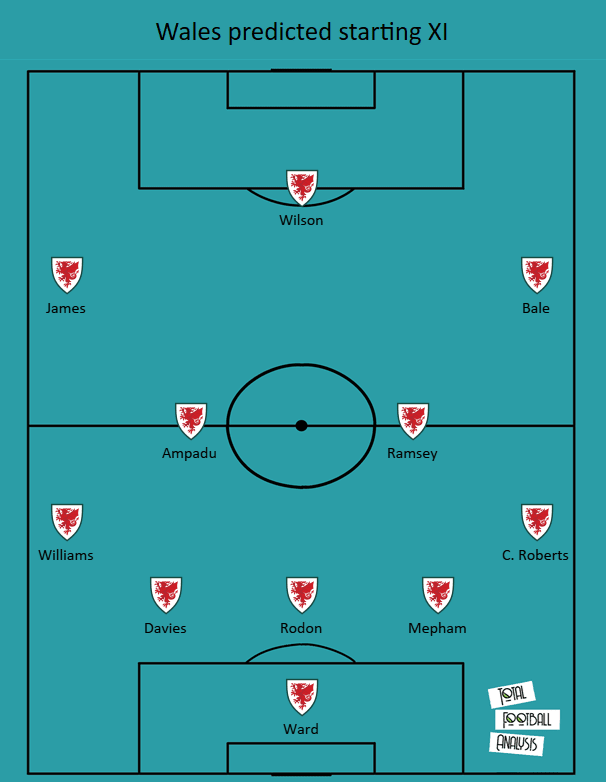
The average age of the Wales squad is just about 26, making them one of the younger sides in the tournament and if we look at their strongest starting 11, the average age is a year younger at 25. This starting lineup could get younger still, with a few injury concerns looming but considering a fully fit squad, we feel this would be the 11 that Page would ideally start every game with. While Giggs’ preferred formation has been the 4-2-3-1, the recent trend with Page appears to be a 3-4-3/5-2-3, with wing-backs and three center-backs. Heading into a major tournament, we feel the Page would probably continue with this formation considering how vital defensive solidity can be at such competitions.
Between the sticks, Danny Ward has taken over the gloves from Wayne Hennessey since the latter’s injury and we expect him to be rewarded for his performances in that time with a place in the starting lineup. Ahead of him, Chris Mepham and Joe Rodon have impressed and should Ben Davies be fit, we expect him to complete the back three of the side. However, his fitness is still in doubt having missed the last few of Tottenham’s fixtures and if he does not make it, we expect James Lawrence to take his place on the left of the back three.
As for the wing-backs, Neco Williams and Connor Roberts are the pair that are expected to start, despite the former being a right-back naturally. Williams has consistently played in the left-wing-back role for country, ahead of the likes of Rhys Norrington-Davies and the pair’s performance at the tournament will surely be interesting to watch. In central midfield, injury concerns may mean that our expected pair of Ethan Ampadu and Aaron Ramsey may in fact not start, but when fully fit, this should be the starting pair. Ramsey has been a constant injury concern and has not played much for his country recently but with his experience, he should be a starter when fit. Ampadu, meanwhile, has missed the last few fixtures of Sheffield United’s season and his fitness is still up in the air as of writing. It does not help Page that another key figure in Joe Allen is in a race of his own to recover from injury, having come off within six minutes in Wales’ World Cup Qualifier game against Belgium in March. Allen has not played for his club since then, and should none of these three be fit, Joe Morrell, who probably makes a case to start regardless, should line up alongside Matt Smith.
The front three is probably the most exciting aspect of this Wales lineup, with plenty of pace on offer. Daniel James missed a chunk of games for Manchester United towards the end of the season but has returned from injury and will take his place down the left wing, with captain Bale starting down the right. Despite having an out-and-out center-forward in Kieffer Moore, we expect Page to continue with Harry Wilson in that position, as he has done since taking over, offering the Wales side a dynamic front three that are capable of shifting across seamlessly. Of course, there are chances that Moore may get the go-ahead if Page decides to take a more traditional approach but with the talent of Wilson and the promising signs that this front three has shown in this short span seems too good to change heading into the tournament.
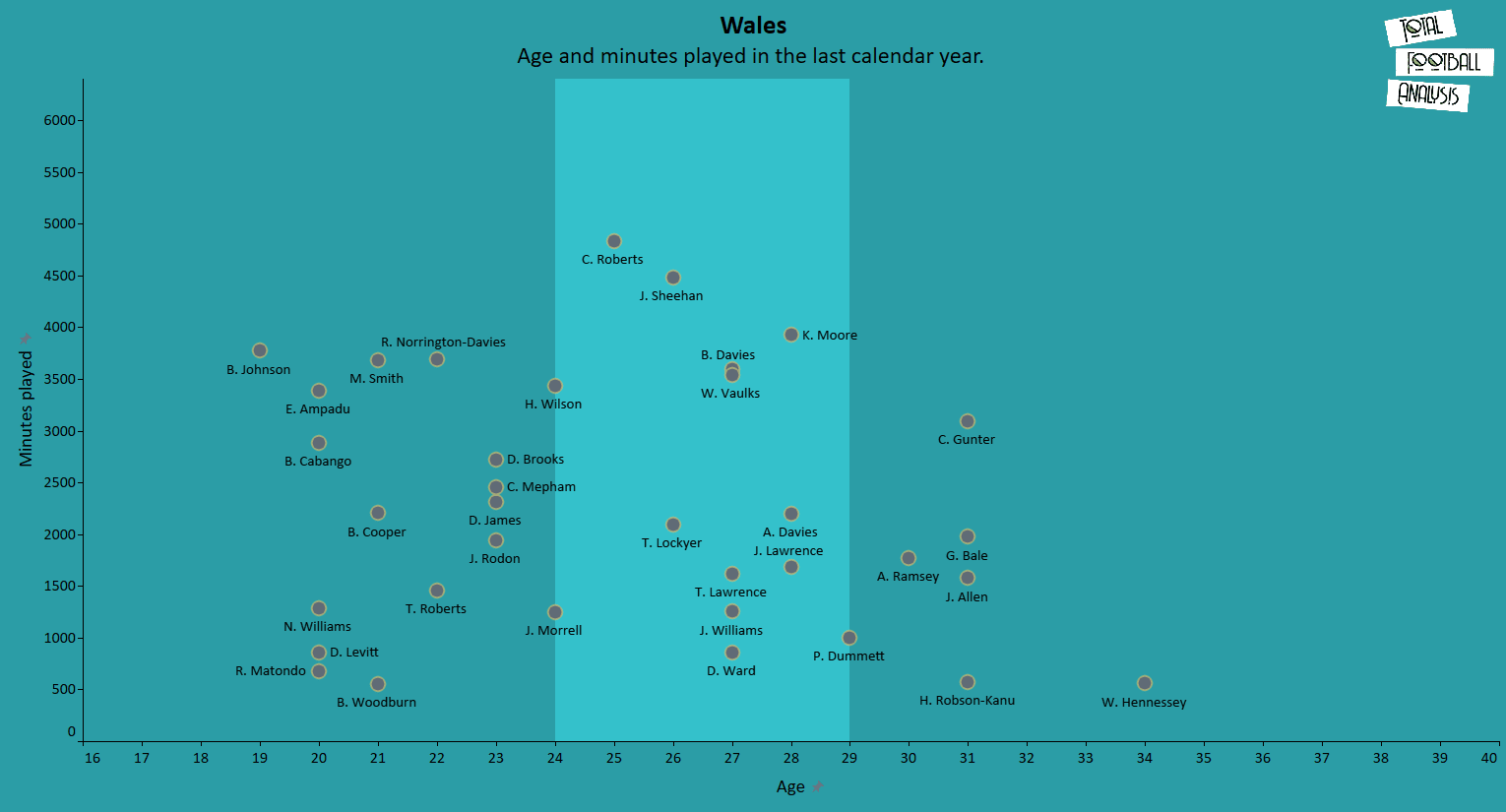
We mentioned the youthfulness of this Welsh side and the above picture shows just that. Of the players to have been called up over the past year, only six of them are aged 30 and above, with 31 being the maximum age for any outfield player. Bale, Allen and Ramsey are three of them and could likely play crucial roles for the side but the remaining three may not feature. Of the 13 players in the peak age range of 24 to 29, Ben Davies and Ward (both aged 27) Wilson (24), and Roberts (25) are expected to start if fit with Morrell (24) being the other likely candidate.
This means that a host of first-team options fall under the youth age range and is quite a promising sign for the Wales side. Mepham, James, and Rodon are all 23, with Ampadu and Williams still just 20 years old. This accounts for five of our predicted starting lineup and apart from them, the likes of David Brooks (23), Smith (21), and Norrington-Davies (22) may still play important roles at the tournament.
It is always a gamble to head into a major competition with a young side but considering the minutes that they have played for their respective clubs in the last calendar year, the squad is quite experienced in terms of game time, though the level that they have been playing at may not be as high as that of Euro 2020. However, Wales can still take joy from the fact that their core group of players still have many years ahead of them and could potentially play in three to four more major European tournaments.
ATTACKING PHASE
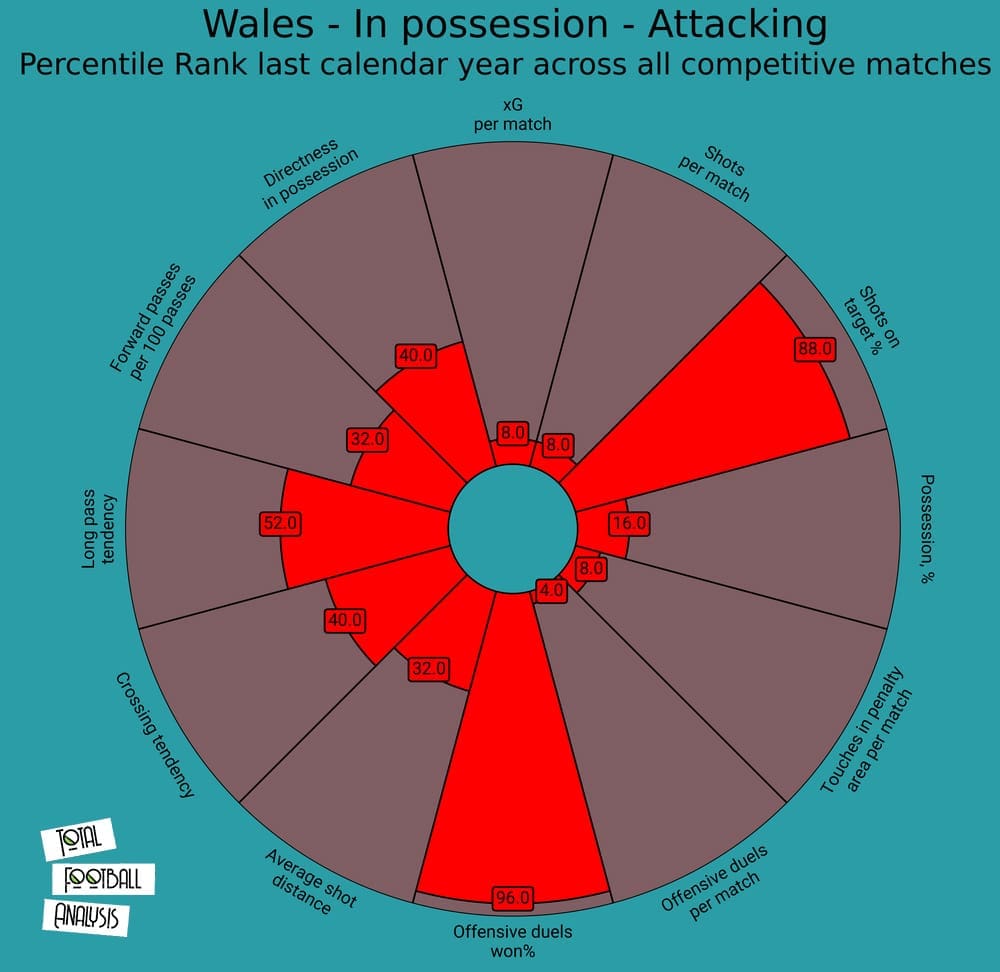
Looking at the attacking statistics of Wales, it does seem a bit underwhelming at first glance, but to put it in perspective, the side have only scored 10 goals in nine games with three of those coming in a single match. Of the remaining eight games, the side won six by score lines of 1-0 with the remaining fixtures being a 0-0 draw and a 3-1 loss. This may look poor on the face of things but for a short knockout tournament, it just might be key in going as far as possible. The side rank in the 16th percentile for possession and in the 8th percentile for expected goals, shots per match, and touches in the penalty area per match as well. However, they rank in the 88th percentile for shots on target percentage and this is quite interesting since it shows that in spite of their low frequency of chances, they are somewhat clinical in front of goal.
Another interesting point to note is that the side rank in the 4th percentile for offensive duels per match but in terms of success rate are in the 96th percentile. This goes to say that though the side are not ones to attack in large volumes (apart from maybe the odd game, for example against Finland in November), they do so efficiently and is possibly the best thing to ask of a national side at a major tournament. The next few metrics give us a clearer idea of Wales’ style of play, showing a lower crossing tendency and directness in possession but an above-average long pass tendency as well. Their average shot distance is also low and they play a lower number of forward passes per 100 passes as well and all this could lead us to believe that the side makes use of counter-attacks, utilizing the pace of James and Bale especially to attack the opposition. Of course, the data does not suggest an overreliance on counters but rather that the side largely looks to pass the ball around in the build-up looking for central spaces but are also keen to play in their pacey wingers should the chance arise.
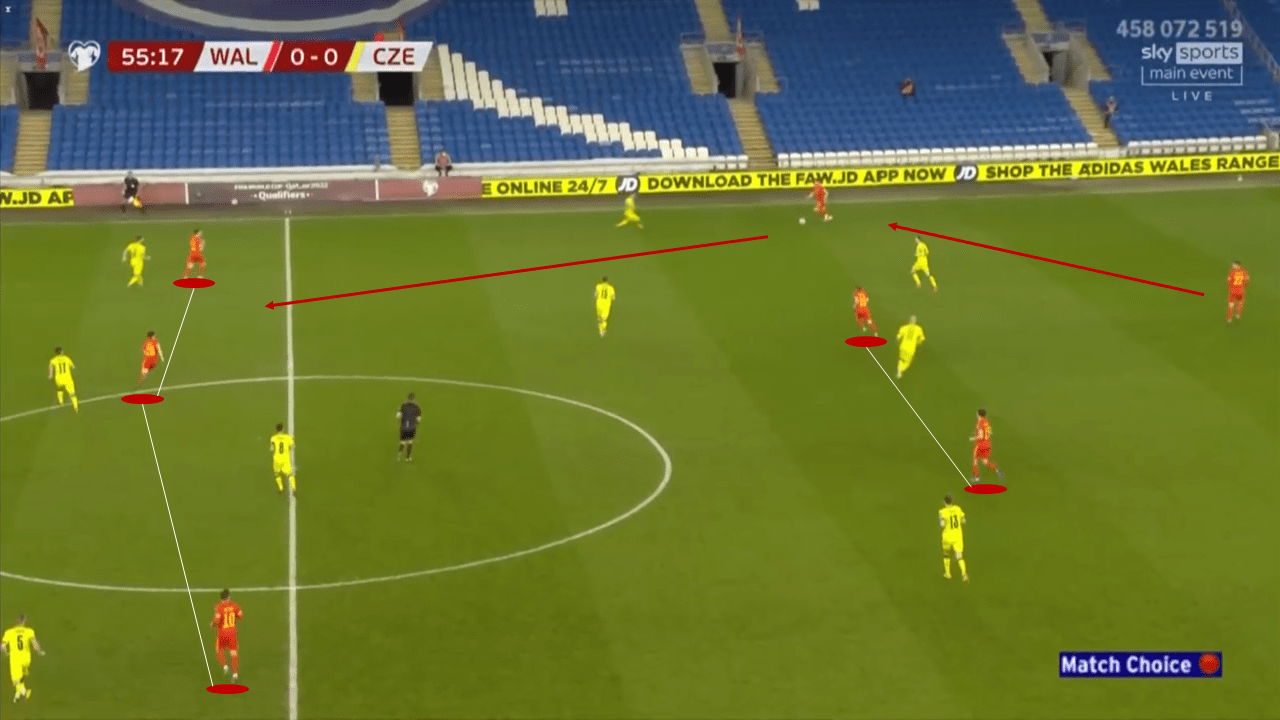
Wales naturally shift to a 3-4-3 in possession and what we saw with the data backs up their style of play. The two central midfielders are no natural creators on the ball, meaning Wales look to pass the ball to the wing-backs who can then play the ball directly to the forward line. There is a clear attempt to break the lines of the opposition quickly, allowing the pacey wingers to have more space and hence making them more threatening.
Sometimes, when pressed high, the wing-backs have to drop deeper and then we see the long passes being played forward into space for the wingers to chase. One might think that it should be easy to defend against such tactics by simply committing more men to the flank, but Wales ensure that they cover this as well.
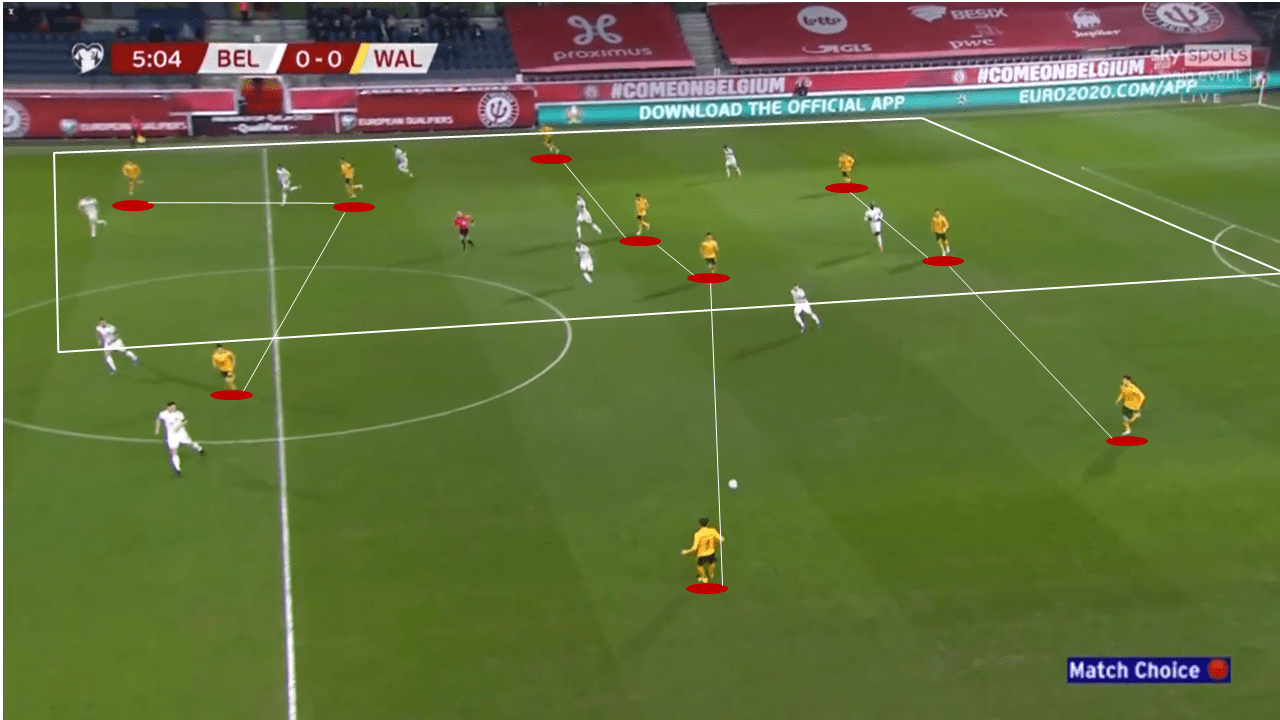
When in possession, Wales look to make the pitch as small as possible, basically overloading one-half of the field. This forces the opposition to do the same and when this happens, the wing-back on the opposite side provides some width, meaning he is an option to quickly switch the play. He would then find himself in large spaces with room to burst forward and by this time, the winger down his flank also makes a run-in behind with the rest of the forward line darting forward as well.
As a result, instead of the opposition committing men to the flank to snuff out Wales’ attack, Page’s side pushes themselves into those areas, drawing the opposition in while also providing passing options for the ball carrier before quickly switching the play and attacking the now vacant opposite flank. The pace of the forwards also means that the opposition cannot leave a man wide to cover the wing-back as this would mean that space would become available in the center where the forwards could move in and attack.
DEFENSIVE PHASE
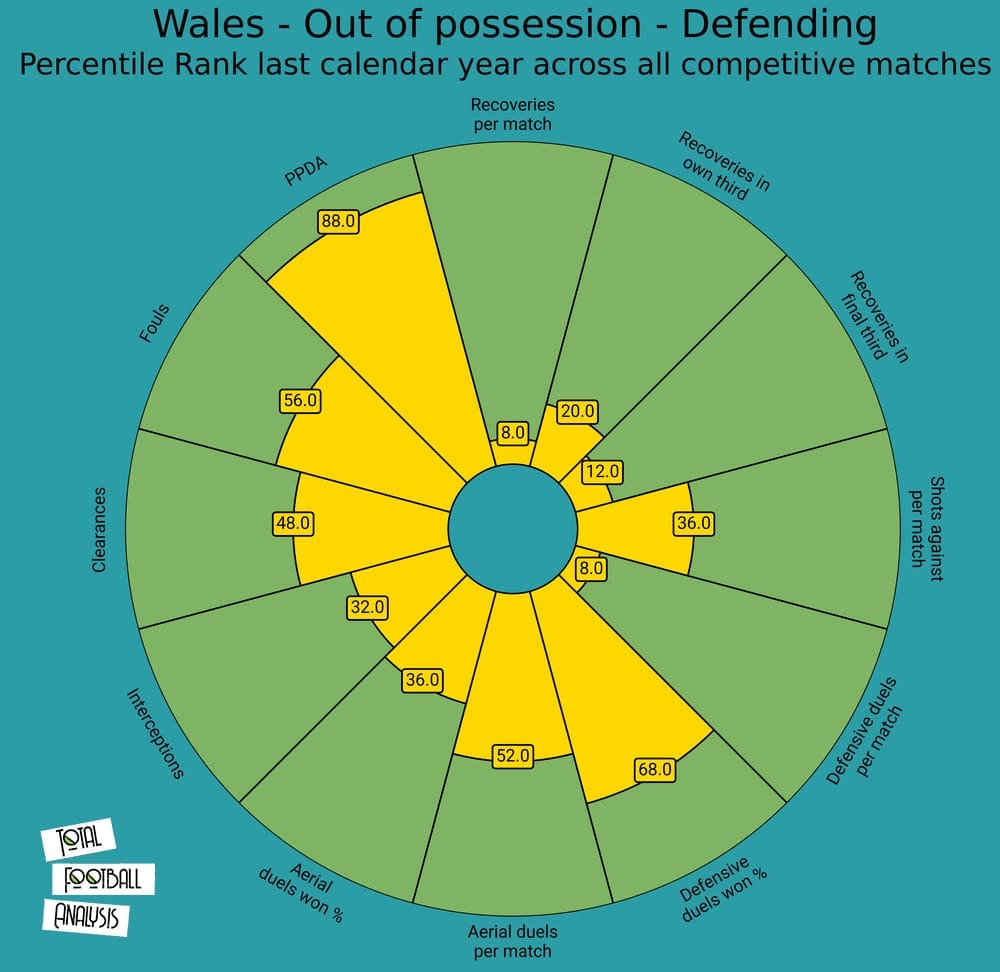
It just seems like the Wales side does not look impressive statistically, ranking lowly for multiple defensive actions as well. However, we mentioned their record earlier and the side has conceded just four goals in their last nine games since 2020, with three of those in a single game against Belgium in the World Cup qualifiers. This defensive record is impressive for any side but then the question arises as to why they fare so lowly in terms of their data. Their Passes Per Defensive Action (PPDA) metric gives us some insight into this, as we see the side in the 88th percentile for this metric. This means that Wales do not actively try to regain possession of the ball and are instead focused on maintaining their defensive shape and seeking to cut down the opposition’s options on the ball.
This seems to be working as well, as despite ranking lowly for recoveries, defensive duels, and interceptions, the side rank in only the 36th percentile for shots against per game. Obviously, the lower the number of shots faced, the lesser the chance is of conceding and this seems to be Wales’ defensive style. We also see them rank above average for defensive duels won, again showing that despite lower volumes, the side carries out their duties efficiently.
Other interesting points to note are the fact that the Wales side rank about average for aerial duels per match and clearances as well. The aerial duels won percentage is on the lower side, but this suggests that owing to their passive style of defense and compact shape, the opposition may turn to long balls and crosses to try and score, possibly a reason for the lower number of shots faced as well. Perhaps the only thing they could be worried about is the slightly above average ranking for fouls but otherwise, it just goes to show that the style of play incorporated by Wales seems to work and as we said earlier, they show signs of being a perfect knockout tournament team that can grind out results.
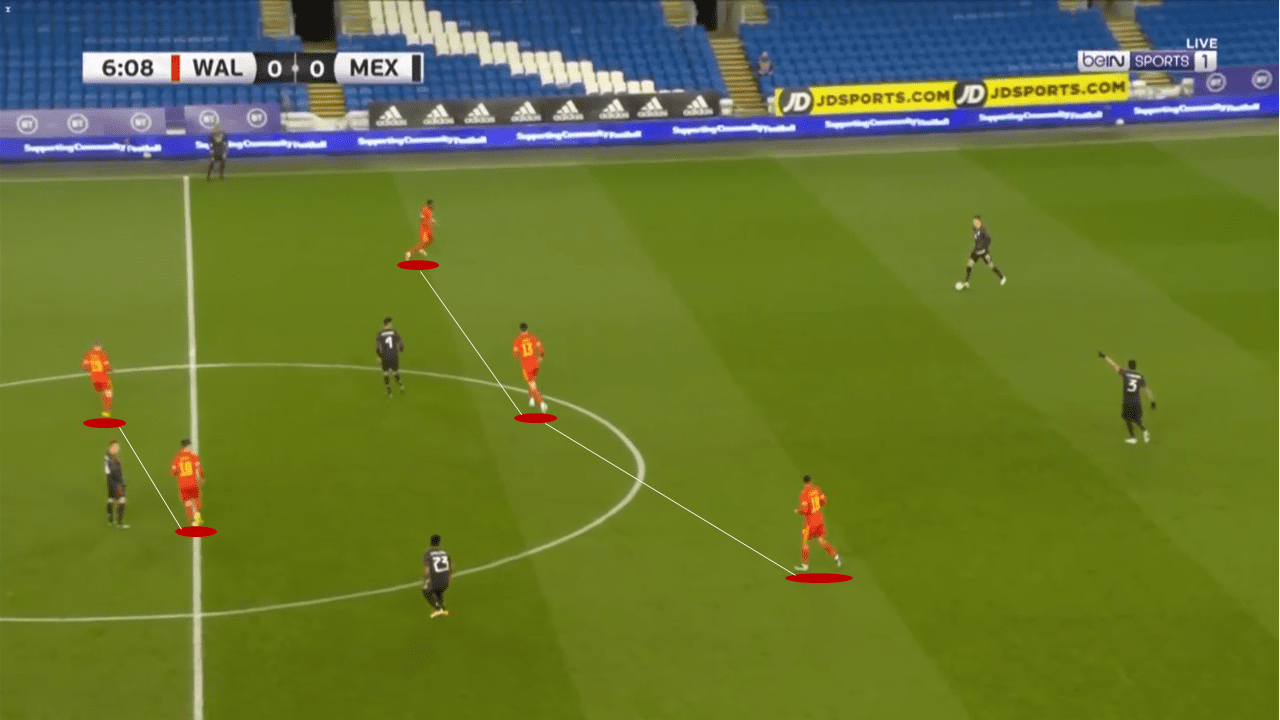
Wales move back into their 5-2-3 without the ball but with just two players in midfield, there is the chance that they may be outnumbered in the center of the pitch. However, here is where Page makes use of the front three to help his central midfielders, effectively cutting out the passing lane to the opposition’s midfielders. This then prevents the opposition from regularly playing through the lines to bypass the Wales defense and hence forces them wide, where a wing-back can then push forward and try to engage an opponent.
It is crucial for Page’s side that the front two lines of this passive press do not have a major gap between them in order to prevent the opposition pivots from finding space in midfield. Moreover, the two lines need to be pressing in tandem, as since it is a passive press if one player pushes forward to engage an opponent, it could leave a gap behind them that their teammate may not be able to cover.
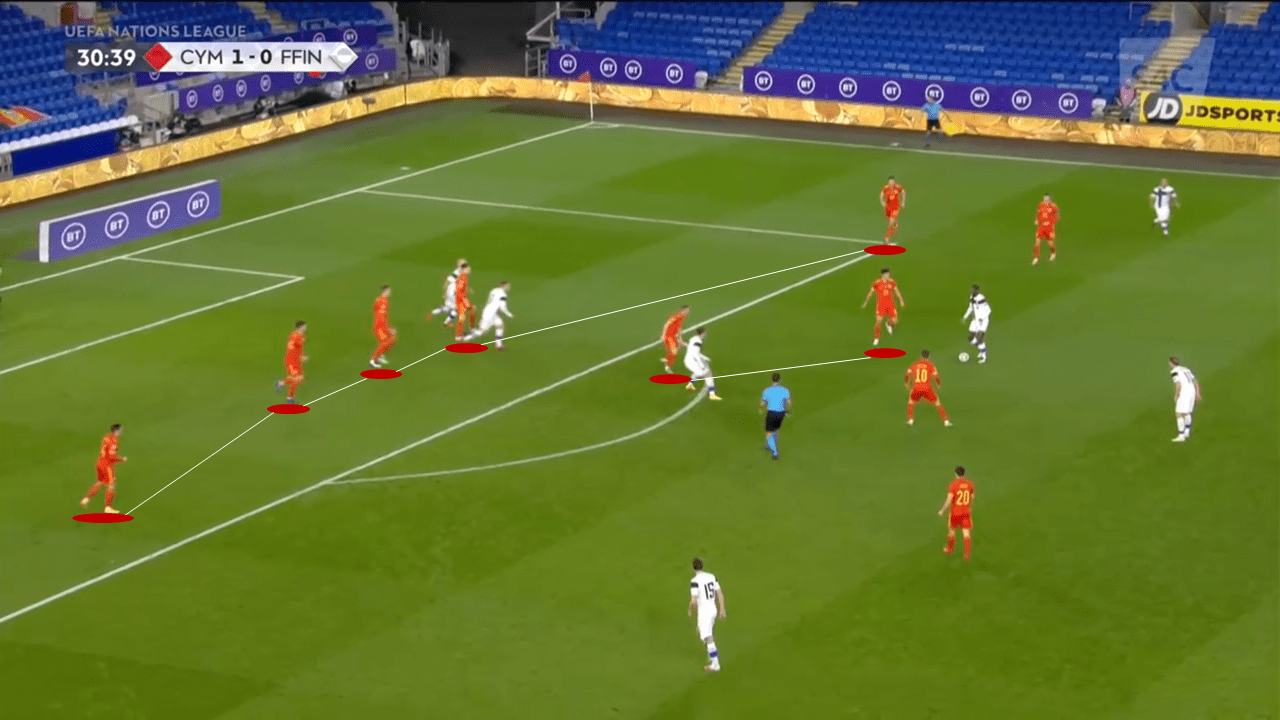
Further back, it gets into a very compact and deep set-up with the forward line dropping deep as well. We mentioned earlier that the two in midfield could get outnumbered and hence it is again important that the forward line drops back to add some support to prevent the opposition from finding space on the edge of the box. The centre-backs may also push forward to engage if an opponent finds some bit of space and in this way, Wales prevent any sort of central progression, reducing the attack to shots from outside the box or hopeful crosses from the flanks. This is a reason why the defense has been quite efficient since they have not allowed the opposition to regularly create quality chances for themselves.
TRANSITIONS
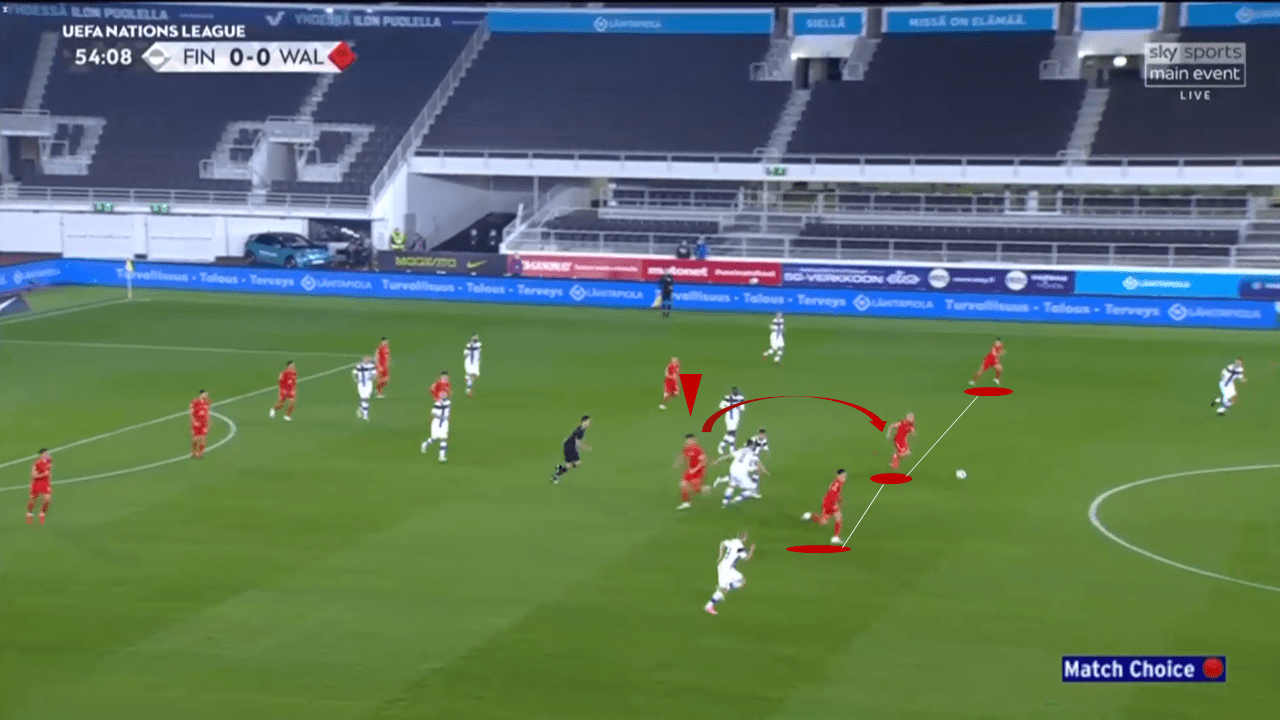
Counterattacks are probably Wales’ best form of attack, with the pace of the front three crucial to their goal-scoring ability. Their long passing tendencies were low from the data shown above but this is due to their side defending so deep. There is no outlet for a pass that is well forward but the side relies on one forward to receive the ball within their own half, hold up play and lay it off for a teammate in support. The wingers burst forward to provide passing options as well, and sometimes the pass may go directly out to them depending on where the ball has been won. This effectively means that at least three players look to get forward in this transition, with supporting players, be it the center-forward or midfielders, coming forward.
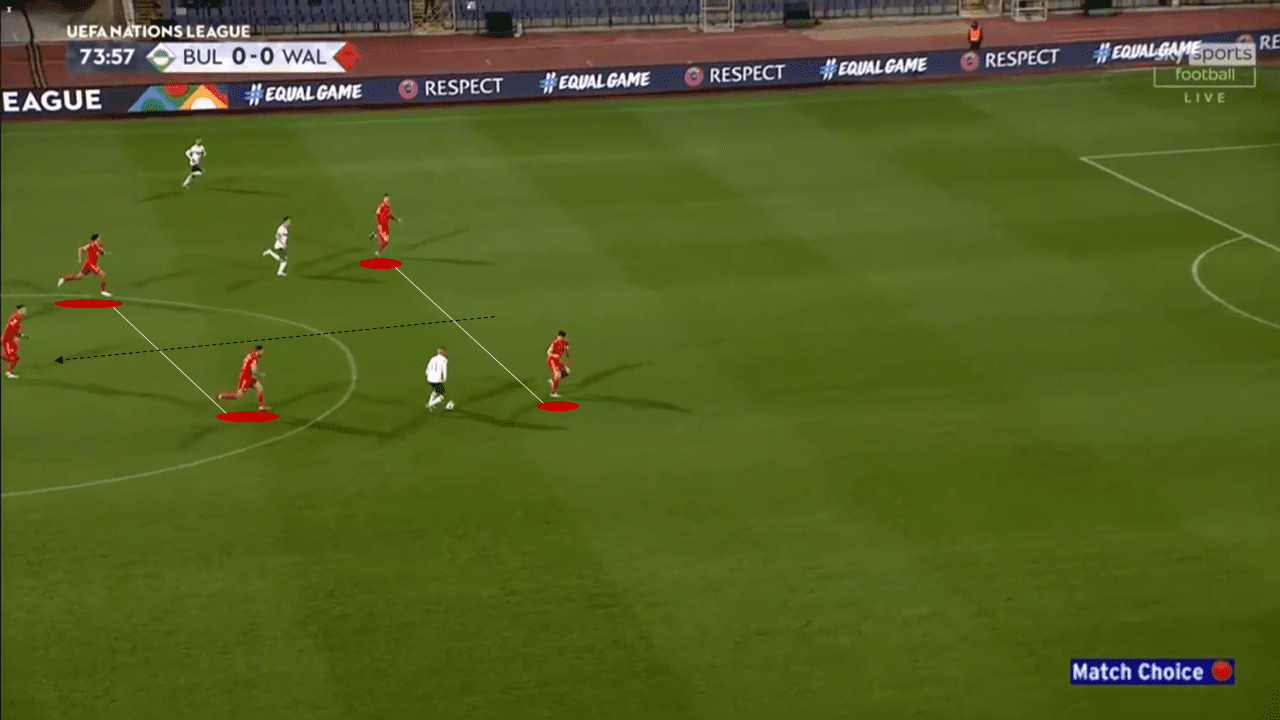
In defensive transitions, Wales have the benefit in that they always have at least two of their center-backs behind to deal with counterattacks. The third center-back will push forward to engage the ball carrier and look to dispossess him, stalling him to allow the midfielders to drop back as well. The remaining two center-backs will hold their line, not committing till as late as possible to prevent the opposition from beating them and running into space. They look to position themselves in such a manner that they can cut out of the passing lanes available to the ball carrier, aiming to isolate them and stop the counter. More often than not, they manage to get back in time to snuff out the attack and can regain possession of the ball.
FORWARDS

Taking a look at the Welsh forwards this season, we see some promising statistics for Bale, who despite playing fewer minutes since his return on loan to Tottenham, leads the way for shots per 90, expected goal contribution per 90, and actual goal contribution per 90. Bale also ranks second for touches in the box per 90 and the national side will need him to be on form if they are to go deep into the tournament. Interestingly, we see Wilson ranks much lower for shots and touches in the box per 90 but he in fact overperforms his expected goal contribution. If he is to line up as the center-forward for the Welsh side, he will need to have his shooting boots on but the stats do suggest a clinical nature, which is good for the side.
James is the other key forward and he just about matches his expected goal contribution while having the third-highest touches in the box per 90. He has, however, operated more as a right-winger for Manchester United, leading to fewer shots per 90 but when playing down the left, we can probably expect more. Of the remaining, Moore and Brooks impress, with good statistics all around and even though they may not be starting every game at the Euros, we do expect them to play key roles of the bench at least, providing an extra attacking threat in case the side are in search of a goal.
MIDFIELDERS
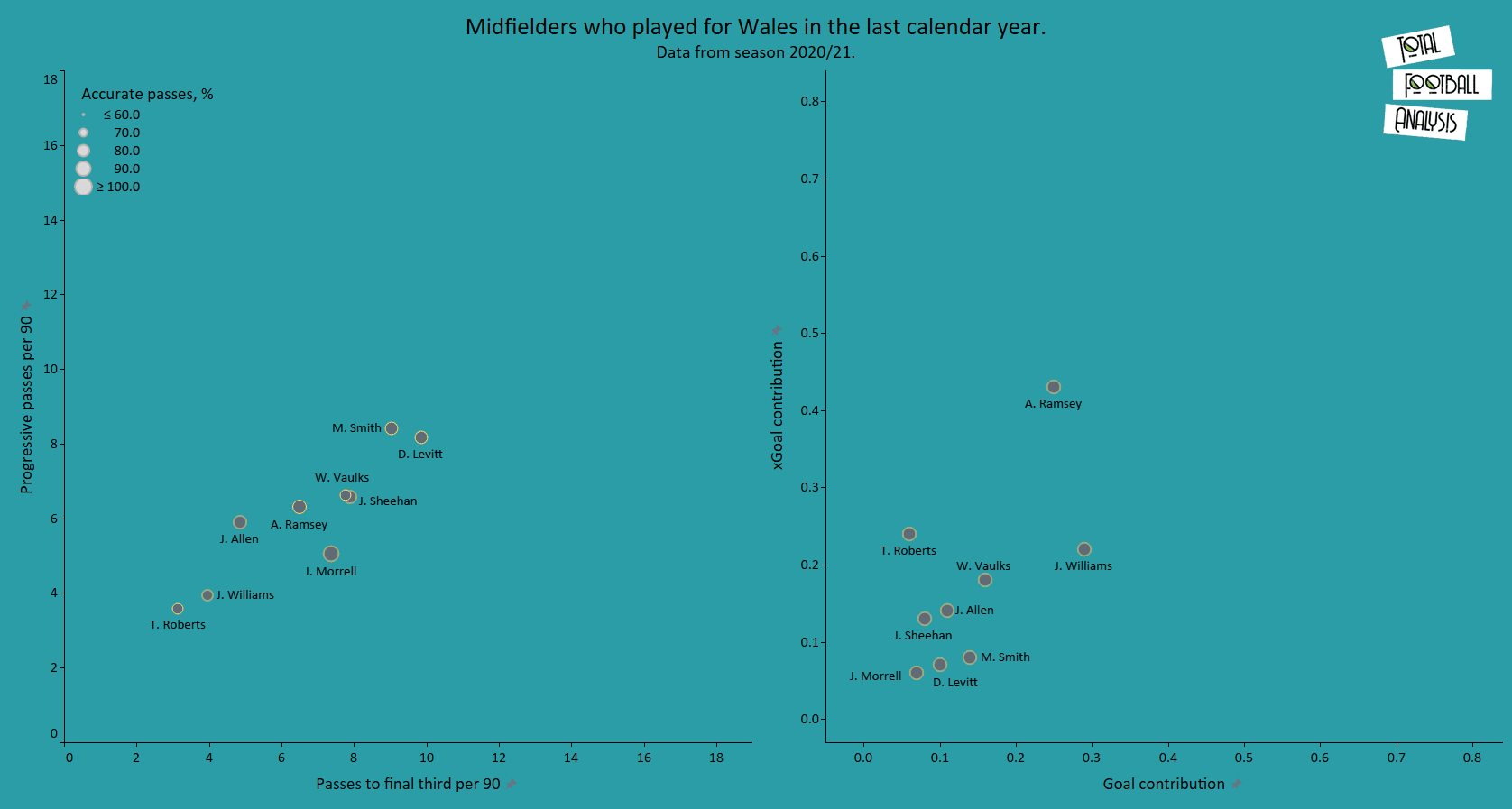
For the midfielders, Ramsey is well clear in terms of expected goal contribution but his actual value somewhat underperforms. His passing has been decent but it is Smith and Dylan Levitt that have impressed in this area, ranking one and two for progressive passes and passes to the final third per 90. Allen and Morrell show decent passing stats but their goal contribution is underwhelming, but nevertheless should form a key part of the Welsh side.
Ampadu is one who does not feature in these metrics but this is due to the fact that he plays as a center-back for Sheffield United, and operates in midfield only for his country at the moment. We mentioned earlier that the Wales midfield department is their biggest concern heading into Euro 2020, considering a host of injuries, but they do seem to have some depth in this area, with Ramsey, Allen, Ampadu, Morrell, Smith, and Levitt all good and promising players that could start if needed, with the likes of Tyler Roberts, Will Vaulks, Josh Sheehan and Jonny Williams also having good statistics this past season and ready to serve as strong alternatives as well.
DEFENDERS
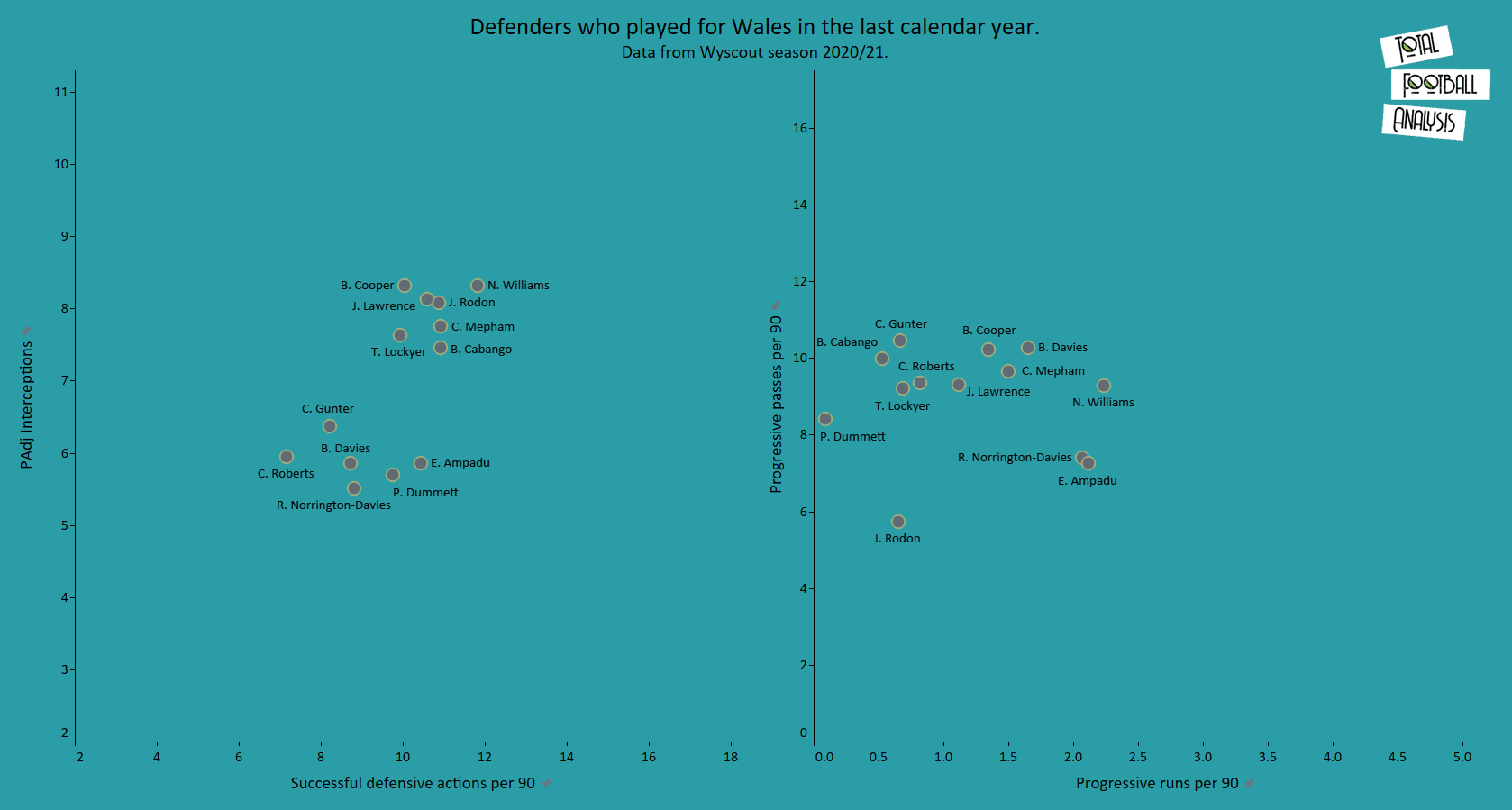
Looking at the defenders, Williams is a standout, ranking highest for successful defensive actions and progressive runs per 90 while just about second for Possession Adjusted (PAdj) Interceptions per 90. Rodon does well defensively and Mepham has a good mix of defensive and progressive statistics and this bodes well for two of our predicted back three for Wales. Davies was our other predicted center-back, and he shows excellent progressive statistics but ranks lower for his defensive metrics. Should he not be fit though, his replacement of Lawrence ranks well in both areas and should be able to cover for him easily.
As we mentioned earlier, Ampadu has played as a center-back and hence we see his statistics here, though they have been underwhelming overall considering Sheffield United’s poor season which saw them finish bottom of the Premier League table. Roberts was the man that we picked to start as the right-wing-back and while he ranks lowly defensively, his progressive passing does look good.
BEST PERFORMER
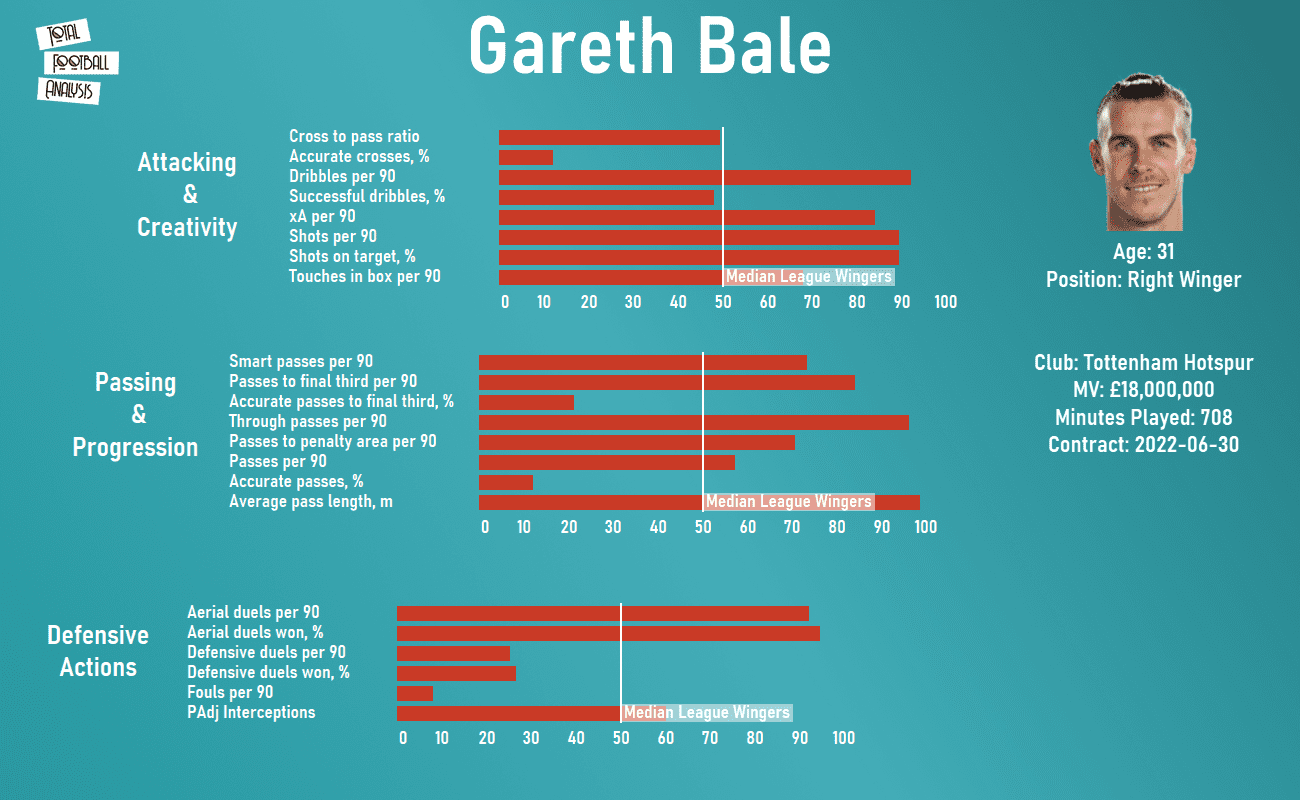
There is no surprise with our choice of Bale as the key performer and it is clear that the forward needs to fire if Wales are to go deep into the tournament. His career has changed a lot since his last involvement in the Euros where Wales went till the semi-finals but the captain’s ability is undoubted and with all his years of experience at the highest level, there will be big expectations on his shoulders. Despite significantly lesser minutes for Tottenham this season, Bale’s attacking and passing statistics do look good, with the forward ranking highly in areas such as dribbling, shots, touches in the box, and expected assists as well. Interestingly, his average pass length is one of the highest in the league and for a side like Wales, that would be crucial especially when they look to counter quickly or switch the flanks during an attack. Even otherwise, his passing into the final third and penalty area is better than the league average, as are his through passes as well.
Defensively, Bale’s strength in the air is highlighted by his high ranking for aerial duels and its success rate as well, meaning he is a threat in the opposition box as well. He also shows a good number of PAdj interceptions and would be an important player in Wales’ defensive phase. He does not, however, engage in many defensive duels but considering that Wales have a more passive style of defense, this should not be an issue.
At 31, Bale does seem past his peak though flashes of brilliance provide some hope for his fans that he may not be done just yet. However, with minimal playing time at club football level, Bale’s future is uncertain but it does look like his days of playing for the national team in major competitions are numbered. Of course, the famous poster that read “Wales. Golf. Madrid. In that order” showed his commitment to the Wales side but he would be 33 by the time of the next World Cup, should Wales qualify, and 35 by the time the next Euros come around so this might just be one of his last chances to shine on the world stage for Wales.
Predictions for the tournament
Wales find themselves in Group A, with Italy, Turkey, and Switzerland and it is all to play for considering even third place could be enough to make it through to the quarters. However, if they do finish third, potential fixtures against the likes of Belgium, Spain, Germany, France, or Portugal may await in the Round of 16 and this could be a tough ask for this Wales squad, though an upset cannot be ruled out. If the side does manage to finish second in their group or even top it though, the Round of 16 gets considerably easier, though of course, every knockout game is difficult. It is, however, difficult to see the side going past the quarter-finals, repeating their Euro 2016 run, and making the semi-finals for the second consecutive edition but as we have said right through this analysis, we might just be looking at a side that knows how to grind out results and at a knockout tournament, what more could you possibly wish for.

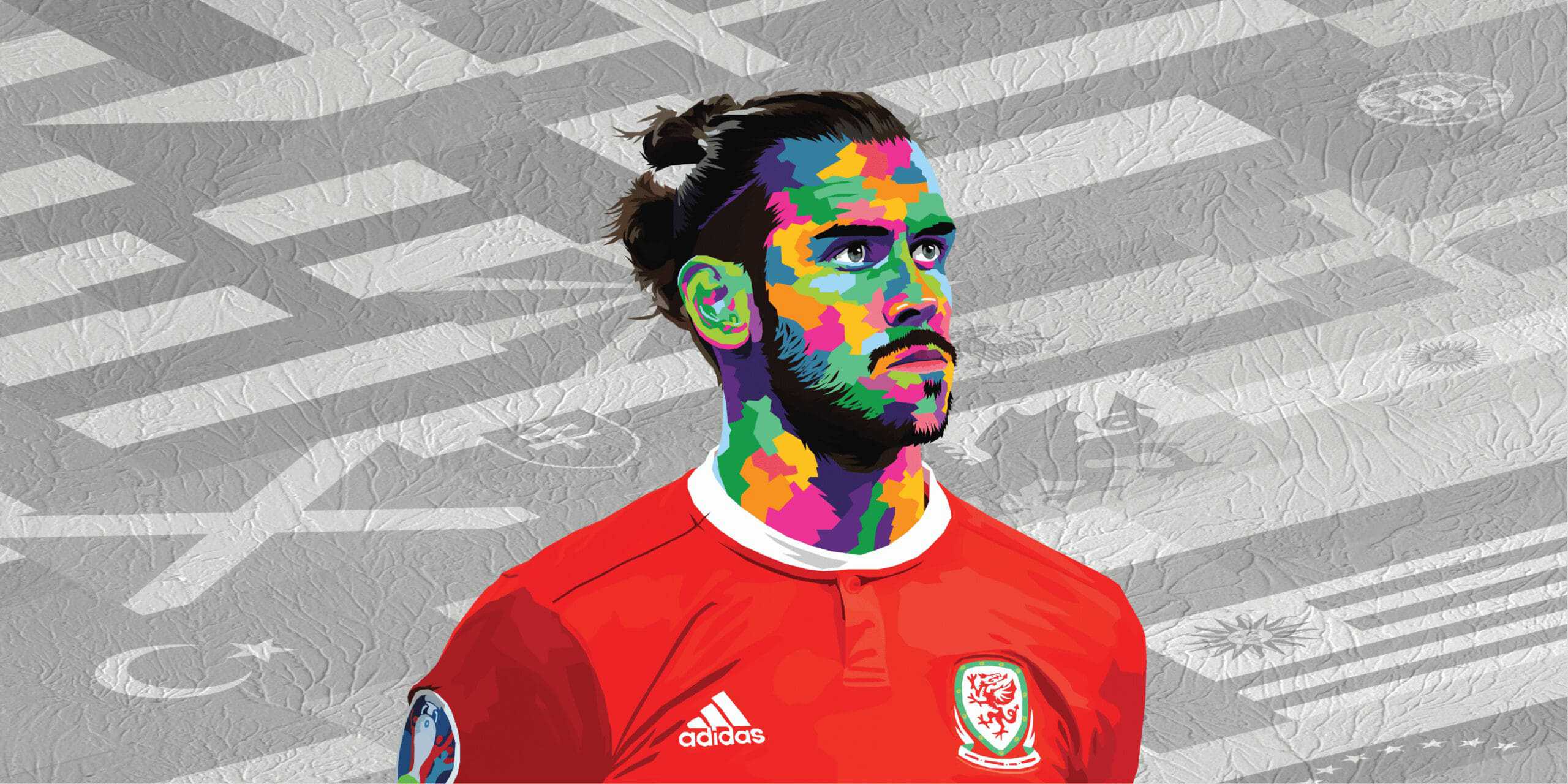



Comments